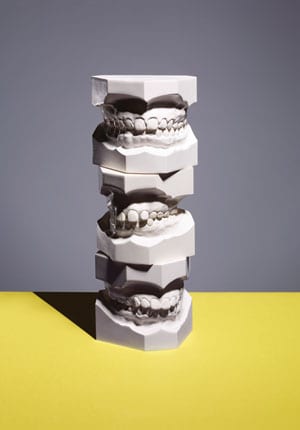
Put down the whitening strips. Imperfect is in.
THE COSMETIC-DENTAL-MAKEOVERcraze that took off in the late nineties (a time when every Tom, Dick, and Harry, D.D.S., began peddling relatively new and untested technology) left a wake of eerily flawless smiles. Now the palpable backlash to Chiclet-like teeth has arrived, creating a demand for a more natural look, one that embraces character-defining blemishes (albeit the sexier ones, like a center gap or subtle uneven edges). Think of it like a good boob job: Your teeth shouldn’t look like you’ve had them done. Here, we straighten out how to get the ideal ivories.
| ORAL FIXATION Dorkfuel readers told us how they feel about pearly (and not-so-pearly) whites. ✓ Forty-four percent of men and 40 percent of women agree yellow teeth are the top turn-off. ✓ Straight men (56 percent) think a gap is ugly; gay men (60 percent) say cute or sexy. ✓ Forty-three percent of men would fix crooked teeth with braces over clear aligners or veneers. ✓ Sixty-six percent of women would date a metal-mouth, but 72 percent won’t let him down there. ✓ According to respondents, Bradley Cooper and Scarlett Johansson have the sexiest smiles. |
• • •
Choose the Right White
A British study found that bright-white teeth are considered unattractive against darker complexions. Could be because real ones aren’t porcelain-colored (when teeth are a blinding phosphorescent, it’s a dead giveaway they’re veneers). Like skin, teeth have certain undertones: “Whatever the tone of a person’s teeth is, they’ll stay in those tones even if you bleach,” says Elizabeth Bakeman, D.D.S. Yellow or orange tones will fade; gray tones will get lighter. But we’re talking degrees here. Getting fakes? Ask that they match the size, contour, and shade of your naturals, advises Bakeman. If you’re whitening your current bite, aim for one or two gradients up from your natural hue. And if that’s not enough to get you to put down the Crest Whitestrips, know that an unfortunate but not uncommon side effect of overdoing it with at-home kits is a layer of gums peeling away like a sunburn.• • •
Yes, You Need a Specialist
There’s a good chance that the guy who does your cleanings isn’t the right person to redesign your mouth. Here’s what to look for when selecting a doc.
Credentials Are a Must
“Cosmetic dentistry isn’t a board specialty, so not everyone has the right education,” says Jack Ringer, a cosmetic dentist in Anaheim, California. “About 30 percent of my practice is redoing bad dental work.” Check for accreditations from associations like the American Academy of Cosmetic Dentistry. While not recognized by the American Dental Association, “the accreditation is held in high regard by the dental community as an accurate barometer of training in the fundamentals of cosmetic dentistry,” Ringer says.
Ask for Examples
A good cosmetic dentist will have pictures and video of the work he did—just as a reputable plastic surgeon would. Be wary of a dentist who only offers up examples from generic books.
Name-Check His Education
If you need a dramatic overhaul, such as a full-mouth reconstruction or crowns and bridges on top of implants, seek out a dental subspecialist, like a prosthodontist. “It’s a combination of aesthetics and biology,” says Manhattan aesthetic dentist Jonathan B. Levine. “Changing the length or width of a tooth can affect bite and therefore function.”• • •
Test-Drive Your Teeth
Three new ways to try on your smile before you buy.
Virtual Reality
“Women come in saying, ‘Make me look like so-and-so female celebrity,'” says Kevin B. Sands, a cosmetic dentist who’s worked on Robert Downey Jr. and Joe Manganiello. “Men don’t seem to care. They just say, ‘Make me look better.'” That’s a mistake: Be specific about what you like and offer examples, then discuss how your dentist can customize that look for you. Many use computer simulations to demonstrate how a grin would look with your features (face size, shape, and bone structure all have an effect); then you can tweak it until it’s right.
Free Sample
For no extra charge, many dentists will create a thin mock-up, like a mouthpiece, that fits over your teeth and lasts a few days before it cracks—enough time for you to judge your friends’ (and your own) reactions. “We want to make sure the patient likes how the teeth look and function,” Jack Ringer says.
Chairside Service
Many doctors, including Sands, staff an “in-house ceramist,” who, after veneers are inserted, works on them for hours painting desired changes—like calcium spots or translucent edges—directly onto the porcelain.
The Case For Adult Braces
The number of postpubescent men opting for orthodontia has grown 29 percent since 2010. Why would any right-minded, self-respecting grown-up spend the money and risk the embarrassment of aligning his teeth with wire when porcelain is quick and easy? Sometimes teeth are so bad they can’t be corrected otherwise. “The greater the complications, like repositioning teeth rather than rotating them, the more likely fixed braces are needed,” says Morris Poole, a Utah-based orthodontist. Is it worth it? Will Smith, an internist, talks about embracing the tween accessory on the cusp of middle age.
“In my mid-thirties, my dentist told me something frightening: My bite was so off that only five of my teeth touched, which could lead to lost bone mass—and lost teeth. If I didn’t want to accept premature dentures, braces were the only solution. I resisted spending the time and money, but my wife spent two years pushing me. Finally, I gave in.
“In the weeks following, I stared at my smile in the mirror. Every day. It was unsettling. But within weeks, I could see the teeth moving—and then it became, strangely, kind of gratifying.
“My front teeth have porcelain brackets, so they’re not that noticeable. Still, I’m eager to get them off. It’s taken three years and a jaw surgery to get to where I am today—41 with a few months left to endure. There is one bright side to having braces: I can commiserate with my 12-year-old son over the difficulties of flossing.”
Open Wide: The Basics of Cosmetic Dentistry
No, you don’t want perfect, but you also don’t want to look like you’ve never seen a dentist (or a toothbrush). Here, the most common fixes for a far-too-flawed smile.
Porcelain Veneer
What It Is: A thin, custom-made cover—like a white grill for the front of your teeth.
What It’s For: Concealing discolored or oddly shaped teeth; or an instantaneous white smile.
What to Know: Veneers must be a minimum of 3/10ths of a millimeter thick—or thicker, depending on how white you go—so room in your mouth must be made by filing down healthy teeth. If you’re a teeth-grinder, don’t get them; they’ll break.
Bonding
What It Is: Resin that’s applied to an existing tooth, like plaster on a wall.
What It’s For: Repairing a chipped tooth, closing gaps between teeth, or covering up discoloration.
What to Know: Bonding isn’t forever. After five to seven years, if the bond hasn’t broken, it’ll look discolored and you’ll want it replaced anyway.
Recontouring
What It Is: The process of shaving down a misshapen or chipped tooth, the way an artist fine-tunes a sculpture.
What It’s For: Fixing small imperfections that don’t require heavy-duty work.
What to Know: “Sometimes this is done for cosmetic reasons, and sometimes it’s a tactile thing,” says Bakeman. “Smoothing and buffing it can make a tooth feel better.” Caution: this strips away layers of enamel, which may leave teeth sensitive to heat, cold, or sugar.
In-Office bleaching
What It Is: Chemical whiteners applied by a pro for about an hour, which the patient follows with 20 or fewer rounds of home treatment.
What It’s For: Erasing the stains of a merlot—or cigarette—addiction.
What to Know: The take-home stuff your dentist offers is the same as the in-office product just at a lower dosage, so Bakeman suggests patients do it themselves. If your teeth are dark, though, don’t expect miracles. “People with yellow/orange tones have a tendency to whiten faster. A gray tone can’t move to a warmer tone, only lighter shades of gray,” she says.
Implant
What It Is: A completely new tooth installed via a titanium root drilled into your jawbone.
What It’s For: Replacing a severely damaged or missing tooth, in a more permanent (and elaborate) way than a bridge.
What to Know: Depending on the strength of your bone and gums, the process may require multiple oral surgeries—dragging the process on for four months to a year.
Bridge
What It Is: A fake tooth attached to two crowns—literally creating a tooth bridge across a former gap.
What It’s For: Saving you from looking like an NHL player.
What to Know: “If I were losing a tooth, I’d want an implant, not a bridge,” says Bakeman. A bridge requires two crowns, which have a 6 percent chance of killing a tooth’s root. An implant leaves adjacent teeth alone. Still, implants are lengthier, more complicated, and often more expensive.
Crown
What It Is: A hollow, porcelain tooth cemented over another tooth
What It’s For: Replacing misshapen, discolored, rotten, broken, or weak teeth—without yanking the original.
What to Know: Your original tooth is ground down to a nub, atop which a temporary crown is placed. Wear that for a few weeks, then return to assess any unwanted changes, like the way you speak. “We’ll pick up subtle things, like a slight little whistle,” Bakeman says. The permanent crown will be made to fix the problem.
Microabrasion
What It Is: Acid and an abrasive (such as ground-up volcanic rock) rubbed against stained teeth like an intense loofah scrub.
What It’s For: Eliminating natural dark spots.
What to Know: If the spot is deeply embedded in the tooth—rather than just on the outer layer of the enamel—more work must be done. Typically dentists drill the spot away, then fill the hole with bonding. Sensitivity may follow.• • •
I Replaced 10 Teeth
Bob Hogan of Orange, California, bought himself a whole new mouth:
“When I was 10, I broke my two front teeth in a bicycle accident. Every few years following, I had to have them re-bonded. By the time I was 30, they were discolored and making me self-conscious. That wasn’t good for my job: I’m the general manager of a Porsche dealership. I’m in our TV commercials. I can’t be uncomfortable smiling.
I thought I needed four teeth replaced (the two front ones, and the two next to them). The dentist pushed for more. I resisted. But we went through different images—squared, rounded, wider, narrower—then he digitally mocked up how he could make my teeth bigger, which sold it for me. I had small teeth, but am 6’4″, 205-pounds, and big teeth fit my face better. So I signed up for three crowns and seven veneers to supplant the 10 teeth in my ‘smile zone,’ and handed over $20,000.
Everything was done in one, three-hour appointment—no anaesthesia, no gas, just novocaine. I lay there with my mouth open. I could hear grinding. I smelled burning. It seemed like my teeth were being reduced down to little pencils. And yet, there was zero pain from start to finish. When it was done, I looked in the mirror and had a whole new mouth.
It took about two months to get used to it; I had never thought about how my teeth and lips feel against each other. I talked funny for a bit. I had to stand in front of the mirror, re-learning how to look natural. But my buddies? They didn’t notice anything. I didn’t tell anyone I’d gotten surgery, and so when old friends saw me for the first time, they looked at me weird and said, ‘Something’s different about you.’ It was the strangest thing—everyone said that. It made me smile.”






